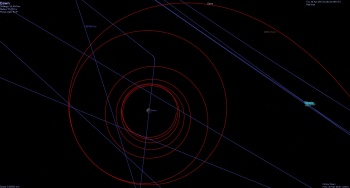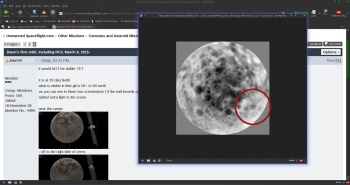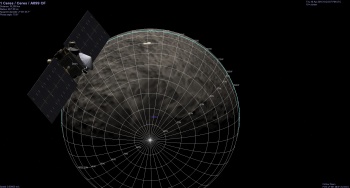Dawn is now officially in orbit around (1) Ceres!
Congratulations, NASA. Nice images of crescent Ceres.
NASA Spacecraft Becomes First to Orbit a Dwarf Planet
Full Version: Dawn's first orbit, including RC3
I thought it was time for a new thread, now that Dawn's in its first orbit. We can look forward to a couple more op navs, on April 10 and 14, and then RC3 later in the month. Use the previous thread for up to Op Nav 5; let's use this thread for Op Navs 6 and 7 and RC3 and then we'll split again once Dawn reaches its first survey orbit.
I thought it was time for a new thread, now that Dawn's in its first orbit. We can look forward to a couple more op navs, on April 10 and 14, and then RC3 later in the month. Use the previous thread for up to Op Nav 5; let's use this thread for Op Navs 6 and 7 and RC3 and then we'll split again once Dawn reaches its first survey orbit.
thanks emily!
i noticed in a prior thread that it said mapping starts in July. thats a bit of a misnomer as mapping starts in Survey Orbit in May (and one can count RC3 as a global map, at about 1.5 km resolution, which is comparable to much of Voyager at Saturn.) wows!
What should nonetheless be correct is that a new mapping phase starts in July, namely HAMO; and that this is still the month New Horizon zooms past Pluto. 
From http://www.nasa.gov/press/2015/march/nasa-...ly-enter-orbit/ :
Does anyone know if a recording of this telecon exists? Normally, at the end of a NASA telecon they offer a number that you can call into to hear it again -- inexplicably, they only offer that number DURING the call itself. Also, JPL will sometimes take the audio and make a video out of it (synced with slides if there are any) and upload to the Ustream or Youtube account.
Or was there absolutely nothing of interest said during the telecon, just the usual recapping of what's happened?
Thanks!
QUOTE
NASA will host a media teleconference at 2 p.m. EST today [Friday] to discuss the historic arrival of the agency’s Dawn spacecraft at the dwarf planet Ceres. ... Participants in the teleconference will be:
- Jim Green, director, Planetary Science Division, NASA Headquarters, Washington
- Carol Raymond, Dawn mission deputy principal investigator, Jet Propulsion Laboratory, Pasadena, California
The teleconference will be streamed live on NASA’s website, at: http://www.nasa.gov/newsaudio
- Jim Green, director, Planetary Science Division, NASA Headquarters, Washington
- Carol Raymond, Dawn mission deputy principal investigator, Jet Propulsion Laboratory, Pasadena, California
The teleconference will be streamed live on NASA’s website, at: http://www.nasa.gov/newsaudio
Does anyone know if a recording of this telecon exists? Normally, at the end of a NASA telecon they offer a number that you can call into to hear it again -- inexplicably, they only offer that number DURING the call itself. Also, JPL will sometimes take the audio and make a video out of it (synced with slides if there are any) and upload to the Ustream or Youtube account.
Or was there absolutely nothing of interest said during the telecon, just the usual recapping of what's happened?
Thanks!
Thanks but that's the PREVIEW briefing, that aired on NASA TV on Monday. I'm talking about the teleconference (media phone call) from Friday.
Searched for it on YouTube:
https://www.youtube.com/watch?v=Qk0Cr0Z13hc
Edit: finally had a chance to listen to it - nothing new was said, really.
https://www.youtube.com/watch?v=Qk0Cr0Z13hc
Edit: finally had a chance to listen to it - nothing new was said, really.
Also the time when the fireworks on 67P are expected to really start.
And Voyager 2 might break out into interstellar space at about the same time also. The values for the interstellar >70 MeV protons have been slowly climbing to the same value as for V2 - though if the current trend holds it might happen a few months later.
Searched for it on YouTube:
https://www.youtube.com/watch?v=Qk0Cr0Z13hc
Edit: finally had a chance to listen to it - nothing new was said, really.
https://www.youtube.com/watch?v=Qk0Cr0Z13hc
Edit: finally had a chance to listen to it - nothing new was said, really.
THANK YOU!!!
It must be an unusual sight. The narrow sickle of Ceres with constellation of Orion in background.
Click to view attachment
Click to view attachment
It must be an unusual sight. The narrow sickle of Ceres with constellation of Orion in background.
Click to view attachment
Click to view attachment
Thanks Peter,
just dipped outside for a look and there is Orion, laying in the west. Go Dawn.
It must be an unusual sight. The narrow sickle of Ceres with constellation of Orion in background.
Click to view attachment
Click to view attachment
Oh my, talk about making the familiar unusual....
I like these perspective jolting moments. My absolute favorite is earth and the moon seen from mercury during the lunar eclipse.
Dawn is currently communicating with Earth. Here's hoping for some of spot(s) 5. 
http://eyes.nasa.gov/dsn/dsn.html
http://eyes.nasa.gov/dsn/dsn.html
JPL has released an animation of the April 10 opnavs. Very cool 
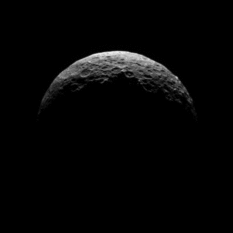
On Twitter, Brian Wolven asked me if the prominent bright peaks seen at the right-hand limb at the beginning of the animation were the two bright spots. I tried to figure out the answer to that, but couldn't. I made the attached polar projection of the northern hemisphere of the DEM from JohnVV's map, but I couldn't match crater features.

On Twitter, Brian Wolven asked me if the prominent bright peaks seen at the right-hand limb at the beginning of the animation were the two bright spots. I tried to figure out the answer to that, but couldn't. I made the attached polar projection of the northern hemisphere of the DEM from JohnVV's map, but I couldn't match crater features.
it would NOT be visible YET in the April 10 images
it is at 20 deg North
what is visible in that gif is 50+ to 90 north
as you can see in these two screenshots ( if the naif kernels are accurate, i have been having MAJOR issues with some of them )
added extra light to the scene
-- FOR APRIL 10 like the gif--
near the center

- off to the right side of ceres
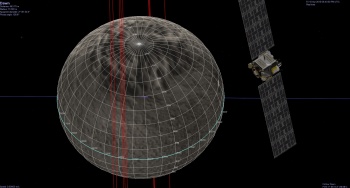
it is at 20 deg North
what is visible in that gif is 50+ to 90 north
as you can see in these two screenshots ( if the naif kernels are accurate, i have been having MAJOR issues with some of them )
added extra light to the scene
-- FOR APRIL 10 like the gif--
near the center

- off to the right side of ceres

Pleasantly surprised to see that OpNav 6 was released today. Something odd happens when I try to extract the individual frames with IrfanView, though: the frames come out in all sorts of sizes.  (edit: never mind, Python to the rescue)
(edit: never mind, Python to the rescue)
In the latest Dawn Journal, it was mentioned that spot(s) 5 would not be visible in OpNav 6:
so I think it would be odd if they suddenly turned up anyway.
In the latest Dawn Journal, it was mentioned that spot(s) 5 would not be visible in OpNav 6:
QUOTE
As we describe below, Dawn’s extensive photographic coverage of the sunlit terrain in early May will include these bright spots. They will not be in view, however, when Dawn spies the thin crescent of Ceres in its next optical navigation session, scheduled for April 10
so I think it would be odd if they suddenly turned up anyway.
I think this mound (or mounds) in the large crater is a good candidate for the limb peaks:
Click to view attachment
Note the trio of craters circled in red:
Click to view attachment
They seem to correspond with the craters in red here:
Click to view attachment
Now extend a longitudinal line over the north pole here:
Click to view attachment
And here (north pole marked with 'N'):
Click to view attachment
The peaks are to the east of the line. The crater with the mound(s) is marked with a yellow box on the longitudinal map.
Click to view attachment
Note the trio of craters circled in red:
Click to view attachment
They seem to correspond with the craters in red here:
Click to view attachment
Now extend a longitudinal line over the north pole here:
Click to view attachment
And here (north pole marked with 'N'):
Click to view attachment
The peaks are to the east of the line. The crater with the mound(s) is marked with a yellow box on the longitudinal map.
With the following assumed globes for PIA19317.gif OpNav6

I've obtained these projections:

Addition of the projections to the DLR map from RC2:

The bright spot is probably just outside frame 20 of the sequence.

I've obtained these projections:

Addition of the projections to the DLR map from RC2:

The bright spot is probably just outside frame 20 of the sequence.
aligning the animated gif with the textured mesh and lat long marks
the other "bright spot" is at 42 N and 0 long.
it is barely visible in the gif
3 frames from the gif with and without a spherical grid
the 0/360 long is top right on the sphere and you can see the major bright spot
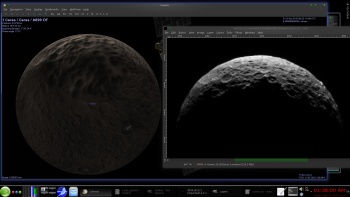

hidden under the horizon
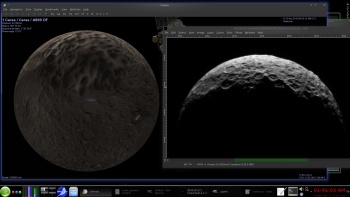
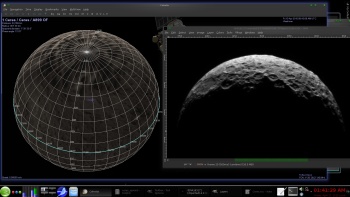
almost visible on the top left
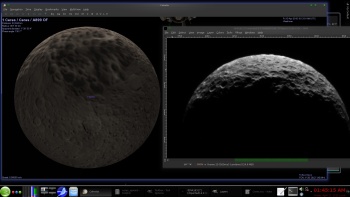
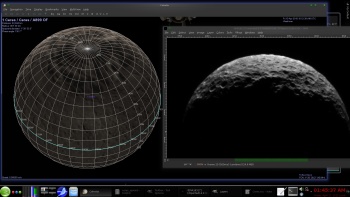
the other "bright spot" is at 42 N and 0 long.
it is barely visible in the gif
3 frames from the gif with and without a spherical grid
the 0/360 long is top right on the sphere and you can see the major bright spot


hidden under the horizon


almost visible on the top left


Ceres rotating back and forth in latest images from Dawn spacecraft.
I find it much easier to spot different surface details this way.
Click to view attachment
I find it much easier to spot different surface details this way.
Click to view attachment
Ceres rotating back and forth in latest images from Dawn spacecraft.
I find it much easier to spot different surface details this way.
I find it much easier to spot different surface details this way.
I can't figure out if bright spot is visible in the animation.
I place here the other available images for more comfortable comparisons:
http://cdn.phys.org/newman/csz/news/800/20...warfplanetc.jpg
http://cdn.phys.org/newman/csz/news/800/20...hisimageist.jpg
https://lightsinthedark.files.wordpress.com...3/pia189231.jpg
http://www.jpl.nasa.gov/spaceimages/images...19056_hires.jpg
I don't understand if I must link them or upload them or insert them in tag so I just add the links.
Im rather curious about these two spots that appear in frame 6 and frame 7. Not necessarily from spot 5 but in the same vicinity. They are somewhat dim and on the left lim.
Click to view attachment
Click to view attachment
ZLD - your map is upside down
That is the two side by side spots that are at 20 degrees NORTH and 240 degrees longitude and is visible in the added light 3d graphic I posted here of the two recreations that show where it WOULD be IF it was lite
http://www.unmannedspaceflight.com/index.p...st&p=219593


you can see in the first image ( added extra AMBIENT light ) to the 3d rendering
That is the two side by side spots that are at 20 degrees NORTH and 240 degrees longitude and is visible in the added light 3d graphic I posted here of the two recreations that show where it WOULD be IF it was lite
http://www.unmannedspaceflight.com/index.p...st&p=219593


you can see in the first image ( added extra AMBIENT light ) to the 3d rendering
JohnVV, thanks much for the simulations with the grids. They really help to put things into perspective.
Also, have you yet added the grid to the global cylindrical map?
Also, have you yet added the grid to the global cylindrical map?
the grid is dynamically added in the 3d program i am using .
Ceres's orbit is calculated using the JPL orbit data and Dawn's orbit is also calculated using it's orbital data the same data that the research scientists are using the naif kernels.
As to the map. The map posted is 0 long to 360 long ( 180 in the center ) a grid could be added ? but not really needed this very EARLY map is very low resolution 1024x512 pixels and the poles ARE MISSING.
In comparison the published Vesta map is 48 ppd ( 17,280 X 8,641 ) pixels .
Ceres's orbit is calculated using the JPL orbit data and Dawn's orbit is also calculated using it's orbital data the same data that the research scientists are using the naif kernels.
As to the map. The map posted is 0 long to 360 long ( 180 in the center ) a grid could be added ? but not really needed this very EARLY map is very low resolution 1024x512 pixels and the poles ARE MISSING.
In comparison the published Vesta map is 48 ppd ( 17,280 X 8,641 ) pixels .
Is the dimmest bright spot resolved in the OpNav 7 images? It looks distinctly elongated in all frames where it "glows":


I don't see how that implies that they are resolved.
Just noting that it looks like it spans more than one pixel at this resolution (and also that it looks elongated from this vantage point). Looking a bit more closely at the images, it seems almost certain to me that it is resolved; but I haven't seen any relevant comments from the science team.
from the tiny gif that is PIA19064
it is looking like the one bright spot at 0 long.( 360 long.) and 42 North
is in fact ejecta from a crater ( i am GUESSING that the OTHER side by side bright spot at 240long and 20 North are ALSO ejecta)
4x enlargements from the 8 bit INDEXED gif
Click to view attachment Click to view attachment Click to view attachment Click to view attachment
it is looking like the one bright spot at 0 long.( 360 long.) and 42 North
is in fact ejecta from a crater ( i am GUESSING that the OTHER side by side bright spot at 240long and 20 North are ALSO ejecta)
4x enlargements from the 8 bit INDEXED gif
Click to view attachment Click to view attachment Click to view attachment Click to view attachment
The surface between the craters looks very smooth. The smooth areas between craters may only appear that way because of smaller craters can't be seen due to the low resolution of the current set of images. But, so far, there does not appear to be mountains or ridges between the craters.
Also, when I imagine a generic crater, say on the moon, I think of the surrounding of it sloping up fairly steeply then the surface dropping sharply as you go into the crater. But I don't see much of a rise on the outside edges of the craters. Are these craters really that smooth or does it look like that because the resolution or sun angle in these images? If they are really that slightly sloped on the outside, could it be because of what might be below the surface or
Also, when I imagine a generic crater, say on the moon, I think of the surrounding of it sloping up fairly steeply then the surface dropping sharply as you go into the crater. But I don't see much of a rise on the outside edges of the craters. Are these craters really that smooth or does it look like that because the resolution or sun angle in these images? If they are really that slightly sloped on the outside, could it be because of what might be below the surface or
do to the fact that Ceres is very high in ices the craters have flat bottoms and are shallow
the one in the crops i posted looks to be on one of the ridges and came in at a very shallow angle
some of the "smoothness "is do to the 4x enlargement and that the original crop was only 128 px on a side ( rather small)
keep in mind that the spacecraft is NOT YET even in a near circular orbit YET
and this set of images is from April 14/15 -- LAST WEEK
the one in the crops i posted looks to be on one of the ridges and came in at a very shallow angle
some of the "smoothness "is do to the 4x enlargement and that the original crop was only 128 px on a side ( rather small)
keep in mind that the spacecraft is NOT YET even in a near circular orbit YET
and this set of images is from April 14/15 -- LAST WEEK
Looking a bit more closely at the images, it seems almost certain to me that it is resolved; but I haven't seen any relevant comments from the science team.
Yes I tend to agree thinking its resolved or nearly so on the first image of the sequence, but on the subsequent images it seem to get saturated and float into adjacent pixel areas -and so larger than it actually is -again

Edit: It's not the first, but frames 8 and 9, the page loaded to slow so I missed the early part of the rotation sequence, but I did separate the images after the post to find out.
Yes I tend to agree thinking its resolved or nearly so on the first image of the sequence, but on the subsequent images it seem to get saturated and float into adjacent pixel areas -and so larger than it actually is -again
The linear arrangement almost has the look of the "Voyager Mountains" on Iapetus...
Performed some slight enhancements on frame 10 of the PIA19064 animation. Cropped, luminance adjustment, deconvolution and scaled 200%.
Click to view attachment
And again with frame 11.
Click to view attachment
These are stretched until the bright region is slightly below max saturation.
Click to view attachment
And again with frame 11.
Click to view attachment
These are stretched until the bright region is slightly below max saturation.
The bright spot seems to be less prominent when on the morning terminator than on the evening. One possibility is that much of the bright material is on a west-facing slope.
Dr. Chris Russell, principal investigator of the Dawn mission, indicated in an e mail today to NBC News that even at the current resolution (1300 2100 meters/pixel) the bright spots were not resolved. This will presumably necessitate a marked revision upward of the albedo of the spots, which was set a minimum of 40 percent, based on the previous resolution of 3.7 kilometers/pixel.
NBC News Article
NBC News Article
The fact that these things were visible from Earth still blows my mind. How small would they have to be before we get in the range of an Enceladean albedo?
This is a "lo-fi" version of our main content. To view the full version with more information, formatting and images, please click here.

